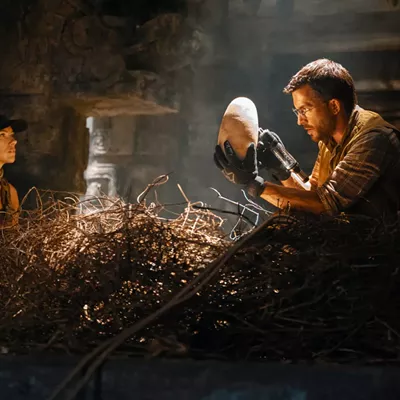A boy named Sam (Jared Gilman) and a girl, Suzy (Kara Hayward), are at the age where they are aware enough of the world to know that it has its problems. Sam is an orphan and unwanted even by his foster parents. Suzy is the child of lawyers. Upper-middle class, probably. Comfortable, but unhappy. Sam acts out with mischief and Suzy with rage and both are labeled “troubled.”
They meet in 1964 and, as pen pals, fall in love over the school year. When Sam returns to Khaki Scout camp the next summer, they run off together to camp out in a world of their own creation because the world of adults they have grown up in is sad and hectic and can’t be trusted.
It’s a first and fateful step to adulthood that has kids begin to create their own realities — governed by the laws and morals that they find lacking in the rest of the world. It’s only fitting that the material Sam and Suzy use to create this first adult reality would include merit badges, Daisy air rifles, science fiction novels and yé-yé pop — those pieces of childhood kids use to play grown up.
Moonrise Kingdom is a diorama to the sort of idealized Northeastern childhood we read about in storybooks and in movies from the mid-’60s — the sort of childhood that Anderson himself, having been born in Houston in 1969, didn’t experience.
Anderson works in American mythos, though, and a Northeastern childhood is both our mid-century ideal and our most potent symbol of the way the American dream collapses under its own weight. It’s perfect for examining the way dreams die and how we try to keep them alive.
Like all Anderson’s films, Moonrise Kingdom is stylized and precious. To say that Anderson’s medium is nostalgia, though, isn’t quite right. Nostalgia is more like the canvas on which he paints. The paintings themselves are full of wonder, glee and the creative power of imagination with contrasting hues of bitterness, malaise and depression.
The way these things — the childlike and the adult — interact creates 100 percent of Anderson’s drama. When his films fail, they fail because these elements are out of proportion.
It’s no coincidence that Anderson’s best and most important film — Rushmore, the film that had critics calling him a visionary and an “auteur” — had these elements perfectly balanced. His worst — Darjeeling Limited, the film that had critics calling him a caricature of himself — was heavily weighted to the malaise and bitterness of an adulthood tainted by the struggles of youth.
That’s still the most compelling criticism of Anderson. The idea that he can only make these kinds of movies in this kind of style.
But why is that a problem? Is there a more fertile ground for storytelling than adolescence? And what more dazzling crop to plant than the intersection of imagination and despair?
Anderson is always meticulous with his crops. That’s never the issue. The trick is harvesting them at the right time, before the sugar of their wonder becomes fermented and bitter with age and spite. Knowing when harvest time comes has always been Anderson’s failing. Anderson picked Rushmore and The Royal Tennenbaums at exactly the right time, but left Darjeeling Limited and, I’d argue, even The Life Aquatic — to crumble in their own depressive malaise.
Moonrise Kingdom is another beautifully tended fruit that Anderson picked perfectly.
















